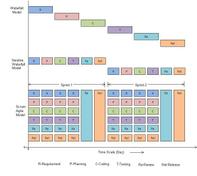ES vs EF vs LS vs LF: Activity Scheduling in Project Management
Advertisement
This page compares and contrasts activity ES (Early Start), EF (Early Finish), LS (Late Start), and LF (Late Finish). Understanding these concepts is crucial for effective project management and scheduling.
Early Start (ES)
Early Start, or ES, is the earliest time that an activity can begin. An activity scheduled near the end of a path, or much later in the overall project, can only start this early if all preceding activities in its path have also started early. Any delay in a previous activity will inevitably push the start date of this activity back.
Early Finish (EF)
Early Finish, or EF, represents the earliest time that an activity can be completed. It’s the date an activity can finish if all preceding activities started early, and no activities encountered any delays or setbacks.
Knowing the ES and EF dates for all activities (tasks) grants the project manager and team valuable insight into the amount of flexibility they have in adjusting start dates without jeopardizing the overall project timeline.
Late Start (LS)
Late Start, or LS, is the latest time an activity can begin without delaying the project’s completion. If an activity resides on a path significantly shorter than the critical path, it can start much later without impacting the project’s final deadline. However, delays to other activities on that path could still cause problems.
Late Finish (LF)
Late Finish, or LF, is the latest time an activity can finish without causing the project to be late. If an activity is on a shorter path, and all other activities on that path start and finish early, it can finish quite late without affecting the overall project completion.
Understanding both Late Start and Late Finish allows you to assess the degree of flexibility within the schedule. A significant difference between LS and LF for an activity indicates more options and maneuverability.
Tips for Calculating ES and EF (Forward Pass)
The “forward pass” refers to calculating these values by moving from the beginning of the project timeline to the end.
-
ES of the first activity = 1
-
ES of all other activities = EF (of the previous activity) + 1
-
Convergence Scenario: If two activities converge (merge) into one activity during the forward pass (as illustrated in Figure 1), then:
ES of activity C = (Greater EF from activity A and B) + 1
-
EF = ES + Duration - 1
Figure 1: ES/LF During Convergence

Tips for Calculating LS and LF (Reverse Pass)
The “reverse pass” involves calculating these values by moving backward from the end of the project timeline to the beginning.
-
LF of the last activity = EF of the same last activity
-
For all other activities (except in convergence scenarios, as described below): LF = LS (of the subsequent activity) - 1
-
Convergence Scenario: If two activities converge (merge) into one activity during the reverse pass (as illustrated in Figure 2), then:
LF of activity C = (Lesser LS from activity A and B) - 1
-
LS = LF - Duration + 1
Figure 2: LS/LF Calculations

Example 1: ES and EF Calculation
Figure 3: Network Diagram for ES/EF Calculation

Let’s calculate ES and EF using the network diagram above:
- Activity A:
- ES = 1
- EF = ES + Duration - 1 = 1 + 6 - 1 = 6
- Activity B:
- ES = EF of Activity A + 1 = 6 + 1 = 7
- EF = 7 + 5 - 1 = 11
- Activity D:
- ES = 1
- EF = 1 + 2 - 1 = 2
- Activity C: (Merge of B and D)
- ES = max(EF of B, EF of D) + 1 = max(11, 2) + 1 = 11 + 1 = 12
- EF = 12 + 7 - 1 = 18
Example 2: LS and LF Calculation
Using the same network diagram as in Example 1, let’s calculate LS and LF.
- Activity C (last activity):
- LF = EF of the same activity = 18
- LS = LF - Duration + 1 = 18 - 7 + 1 = 12
- Activities B and D:
- LF = LS of C - 1 = 12 - 1 = 11
- Activity B:
- LS = LF - Duration + 1 = 11 - 5 + 1 = 7
- Activity D:
- LS = LF - Duration + 1 = 11 - 2 + 1 = 10
- Activity A:
- LF = min(LS of B, LS of D) - 1 = min(7, 10) - 1 = 7 - 1 = 6
- LS = LF - Duration + 1 = 6 - 6 + 1 = 1
Advertisement
 RF
RF





